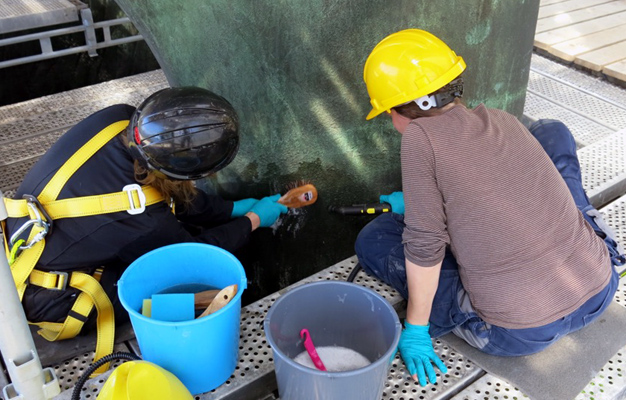
Image of ‘The Arch’ taken from a mechanical lift during the initial condition check

Brown staining on the bronze from a steel bolt inserted at some point in the past

Graffiti at the base of the sculpture

View of the sculpture scaffolding

Washing the surface of the sculpture to remove soils and contaminants

Removing rust staining

Liquids applied to the surface of the bronze had removed the patina to reveal underlying metal

Chemical patina tests

Cleaning the rust stained areas at the top of the sculpture

Retouching areas of rust staining with cold chemical patinas after cleaning

Retouching graffiti damage using cold chemical patinas

The retouched area after treatment

The stained area at the top of the sculpture after treatment

Buffing wax into the surface of the sculpture

The top of the sculpture after waxing

The sculpture after treatment

Henry Moore
'The Arch' 1963-69
Henry Moore chose the site for this sculpture in Huk, a beautiful location looking out over a beach at the edge of a fjord near Oslo. It is cast in bronze by Noack Foundry in Berlin; a foundry that worked closely with Moore in the creation of many of his monumental sculptures.
The sculpture had been displayed outdoors for many years and, despite periodic maintenance, its original patina had slowly altered with exposure to the elements so that it had an overall green colour towards the top, with more brown shades further down. The vertical green run marks seen at the top of the sculpture are the result of surface corrosion caused by water run-off and are commonly seen on outdoor sculptures. Early photos of the sculpture suggest that its original foundry patina was probably dark brown with light green highlights. On the most exposed surfaces the original patina had been weathered away entirely to reveal the underlying bronze.
Moore’s monumental sculptures were often fabricated with lifting bolts so that they could be more easily installed. There were two at the top of this sculpture, one on each side. Unfortunately, steel bolts had been used at some point and had corroded badly over time, resulting in severe reddish-brown staining around the bolts on both sides.
The sculpture was also badly marked with graffiti on the lower parts of both ‘legs’. Some had been scratched into the surface or applied with a fluid that had removed the patina from the sculpture surface, revealing the golden bronze underneath. Other graffiti had caused a green colour to form, which made it stand out against the darker brown background. An anti-graffiti coating had subsequently been applied to the base of the sculpture to prevent further damage.
Our primary aim was to remove or reduce any elements that were not part of the sculpture’s fabrication or natural ageing process, namely the iron staining and graffiti. We then planned to mitigate weathering on the bronze surface using a wax that would help resist the worst effects of the weather in future.
We made the decision not to remove the green weathering streaks, based on our understanding of Moore’s attitudes to weathering in his sculptures. Moore is said to have understood and accepted that his sculptures would change in the outside environment due to weathering. It was felt that the condition of the sculpture would therefore be in keeping with the artist’s intent, providing that it was well maintained and the unsightly elements were removed.
The entire sculpture was cleaned to remove surface soiling as far as possible, then the anti-graffiti coating was removed with solvent gels and a steam cleaner. This removed the resistant layer over the damaged areas, allowing us to locally repatinate these areas and more successfully blend them with the surrounding bronze finish.
We carried out a number of tests to determine how best to remove the widespread iron staining around the bolts on the upper surfaces of the sculpture. Mechanical methods and gels containing chelating agents were used in some areas. In the end we were partially successful in removing the iron stains but it was also necessary to retouch some areas using locally applied chemical patinas.
Finally, a suitable clear wax was applied in several layers, each of which was buffed into the surface using a combination of buffing brushes. It is hoped that this will help protect the bronze from the elements until it is next maintained.
With thanks to:
Lily Vicki and Katharina Kruck, sculpture conservators at Oslo kommune, and Tessa Jackson, sculpture conservator, for their assistance.
Dr Alice Correia who carried out the background curatorial research for the project.
Artist | Henry Moore |
|---|---|
Name | 'The Arch' 1963-69 |
Client | Oslo kommune |
Location | Oslo |